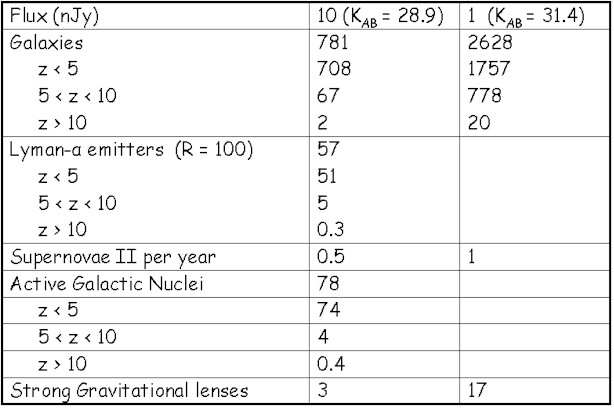 |
| Science |
 |
| Science |
LAMA will provide very high-resolution images of selected regions of the sky. This in turn will allow the detection and study of very faint stars and galaxies. The simulated images shown below illustrate how a very distant galaxy might appear in observations, of equal exposure time, made by the HST, NGST and LAMA.
|
|
|
|
| HST | NGST | LAMA |
Primary Science Goals
The following scientific goals have been identified as a priority for the LAMA project:
Study the process of galaxy formation and evolution from redshift z ~ 20 to the present
Detect and study the first luminous systems
Determine the star formation history of the Universe
Determine the cosmological parameters and the nature of the dark energy
Resolve the innermost regions of AGN and QSOs
Detect and study the oldest and faintest stars
Observing Program
A main observation program of LAMA will be a high-resolution multicolor imaging survey of selected regions of sky. The array will image a 30" x 30" patch of sky every few minutes. Several survey modes are being considered. These differ in the length of exposure time, area of sky, frequency of observation and science programs.
LAMA Deep Survey
Over the course of a year, 360 30" x 30" fields could be observed about 150 times each. This would provide a total exposure time of about 40,000 sec. The total area of sky covered by such a survey would be approximately 90 square arcmin. The 2-um detection limits for these fields is estimated to be approximately 480 pJy (pico-Janskys), equivalent to an AB magnitude of 33.2, for galaxies (0.1" source size) and 120 pJy (KAB = 36.2) for point sources.
Supernova Survey
Distant supernova can be used as "standard candles" with which to measure the cosmological parameters. Type II supernova, which result from explosions of massive stars, are also valuable as tracers of the star formation rate. LAMA will be able to detect Type II supernovae to redshifts z ~ 6 in just 300 seconds of exposure time. It should be possible to detect as many as 100 such supernovae each year.
Distant Galaxies
Lama will detect galaxies as faint as 100 pJy. The number of such galaxies is not presently known, but some idea of the expected counts can be obtained from observations with HST and from model predictions. A rough estimate of the expected number of various kinds of objects, per square arcminute of sky , is given in the table below. Even at a 1 nJy flux limit, the number of high-redshift galaxies is substantial. The number of detectable galaxies having redshift greater than 10 in the LAMA deep field could be as large as 10,000.
Estimated number of objects per square arcminute

QSO Spectroscopic Survey
Over the course of a year, LAMA would be able to obtain very high quality spectra for about 100 high-redshift quasars. By repeating this program over several years, secular variations in the absorption line systems could be detected. This would allow a direct measurement of the cosmic deceleration and would ultimately constrain the equation of state of the dark energy. Transverse velocities could also be measured for the absorbing systems giving new insights into their nature. Such data would also provide unprecidented accuracy for studies of possible variations in fundamental physical constants.
Extrasolar planets
In coherent mode, it would be possible to adjust the phases of light from the various apertures to cancel light from a star, in order to directly detect light from a planet in orbit around that star. This would allow direct spectroscopic studies of reflected light from extrasolar planets which could determine the composition of their atmospheres.
In another technique, starlight passing through the atmosphere of a transiting planet would be imprinted with the absorption signature of elements in the atmosphere of the planet. The large aperture and sensitive high-resolution spectrograph would allow this very weak signal to be detected. The discovery of oxygen in the atmosphere of an extrasolar planet would be a strong indicator of the presence of life.
Links